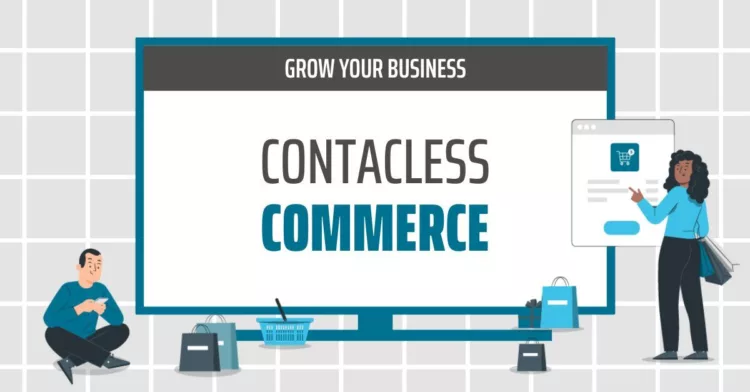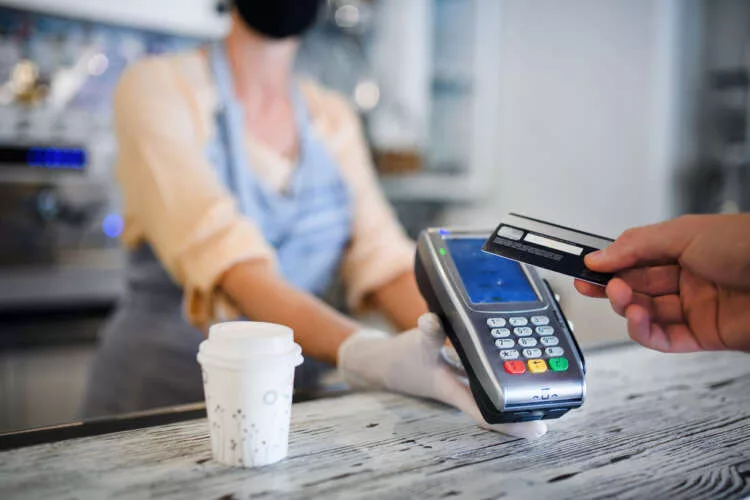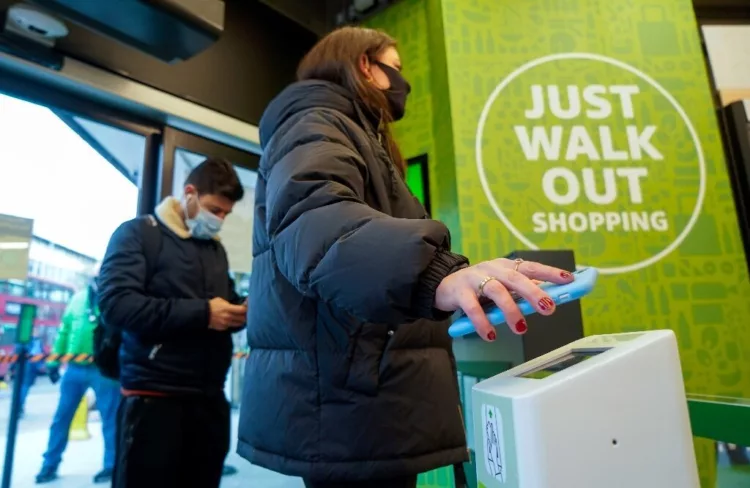Contactless Commerce - Redefining the shopping experience

The pandemic put customer retail experiences to the ultimate test. Fitting rooms, contact with retail agents, cash payments, and in-store product testing were all impacted. Now that the world economy has reopened, retailers have realised the importance of faster, safer, and improved in-store and online experiences that preserve the essence of closeness and interactivity with products, agents, and the store environment. This is where cutting-edge digital technologies come into play, ushering in the era of "contactless commerce" - enabling new, innovative ways of shopping.
Introduction
Finding the perfect suit or dress can be quite the challenge. There's a myriad of factors to consider - size, fit, price, colour, texture, overall appearance, and more. While it might look stunning online, how will it actually fare in reality? The abundance of online returns experienced by retailers indicates that this task is far from simple.
And it's not just clothing that presents difficulties when assessing online. Fresh food, beverages, cars, perfumes, and furniture are all items that we prefer to experience, test, and try before committing to a purchase. In other situations, such as selecting a mortgage or choosing the right bottle of wine, we often seek guidance in making decisions about complex services or products. Though product reviews can be found in abundance online, they rarely substitute the value of a trustworthy human advisor who can cut through the jargon and help us make an informed choice.
And therein lies e-commerce's big challenge. Lots of folks used to think that the main problem was convincing people to buy stuff online, but the pandemic changed everything. Turns out, most people are totally cool with shopping online for anything and everything. The real deal for the industry is that they have to aim to make the buying experience seamless and hassle-free, with as little contact as possible.
Contactless commerce is being enabled by a wide range of new technologies, including machine learning, robotics, computer vision, sensors, big data analytics, augmented reality, and computer-aided holography. It is set to transform all elements of the customer experience, from product comparison to selection to checkout.
A whole host of new tech is democratising and bringing forward contactless commerce. It’s now not just a necessity as it was during the pandemic - the growth of machine learning, robotics computer vision, sensors, big data analytics, augmented reality, and computer-aided holography are all now playing their part. The end to end customer experience is now being uplifted with people getting elevated service and logistic solutions at the touch of a button.

The tech behind contactless commerce
Contactless commerce has emerged has a big segue for business to bounce back post pandemic. For many during that period it was necessary to survive. However a few years on from it all - the contactless shopping experience has evolved beyond just tapping your card on the reader.
At its core, contactless commerce leverages advanced technologies to create a seamless and frictionless shopping experience. Here are some key aspects of contactless commerce:
Online Shopping: Contactless commerce heavily relies on online platforms and e-commerce websites, allowing customers to browse and purchase products or services from the comfort of their homes or using mobile devices. The rise of live shopping via social media and rapid rise of logistics which allow for next day delivery and easy returns have added to the boom of e-commerce.
Mobile Payments: Mobile payment methods, such as digital wallets, NFC (Near Field Communication), QR codes, and contactless cards, are integral to contactless commerce. These payment options enable customers to make purchases without handling physical cash or touching point-of-sale terminals.
Curbside Pickup and Delivery: Contactless commerce often incorporates options for curbside pickup and contactless delivery. Customers can place orders online and receive their items without entering the store or coming into direct contact with delivery personnel. You’re seeing the popularity of these continue to grow especially amongst supermarkets - its now a huge revenue driver for Walmart where people are enjoying the convenience of not having to go in store or even leave their car!
Scan-and-Go Technology: Some stores offer scan-and-go solutions, allowing customers to scan items using their smartphones and pay for them through the app, eliminating the need for traditional checkout lines.
Virtual Try-On and Augmented Reality: In the fashion and beauty industries, contactless commerce utilises augmented reality and virtual try-on technologies, enabling customers to virtually test products before making a purchase.
Voice Commerce: With the rise of voice-activated virtual assistants like Amazon's Alexa and Google Assistant, contactless commerce extends to voice-activated shopping, where customers can place orders and make purchases using voice commands.
Enhanced Customer Experience: By leveraging data analytics and machine learning, contactless commerce platforms can offer personalised product recommendations, streamlined checkout processes, and tailored customer service, enhancing the overall shopping experience.
IoT Integration: Internet of Things (IoT) devices, such as smart shelves and beacons, play a role in contactless commerce by providing real-time inventory updates and location-based marketing to customers.
If you’re a small to medium business explore our blog here how the IoT can benefit you in the long run.

Where do SMB’s fit in
For businesses, regardless of their size, the need to revolutionise commerce cannot be overstated. Finding ways to minimise contact while embracing novel digital experiences has become a key revenue driver for many who actively avoid in-person shopping. Notably, small businesses in the fashion and food sectors have taken the lead in providing contact-free curbside pickup for online and mobile orders. This shift has given rise to the adoption of local payment methods aligned with regional cultural norms. In some areas, e-wallets gain prominence, while others lean towards bank transfers, credit cards, and the popular Buy Now Pay Later alternatives.
The backbone of the global business landscape is formed by small and micro businesses, who contribute over 90% of all enterprises. Their resurgence is vital for the overall economic recovery to take place. To overcome the financial setbacks caused by COVID-19, rising inflation and ongoing geopolitical pressures, SMBs worldwide can start by reimagining the checkout experience. Our survey revealed that almost half (48%) of consumers would hesitate to shop at a store offering only payment methods involving contact with a cashier or shared device. However, an encouraging two-thirds of consumers indicated they would gladly switch to a different business that offers contactless payment options. This shift in approach can be a game-changer for SMBs seeking to thrive in the current market scenario.
Key steps to succeed with contactless commerce
The world of contactless commerce presents a plethora of opportunities - from safer and quicker experiences to immersive content-rich engagements. However, it also brings challenges concerning privacy, data security, elevated customer expectations, and redefined roles for in-store staff, among others. To make the most of the opportunities and address the risks, retailers can consider taking the following actions:
Be mindful of your customers time: With automated, contactless technology saving time for customers and retailers alike, the question arises - how will this newfound time be utilised? Customers may choose to allocate these time savings to other aspects of their busy lives or decide to spend more time in-store, indulging in the delightful parts of the shopping experience. Creating immersive and personalised content-rich experiences will be pivotal in determining the outcome.
Go where your customers are: The world of contactless commerce will blur the boundaries between physical stores and online experiences. AI-powered technology will enable consumers to make choices and purchases seamlessly across different platforms - voice, mobile, online, and in-store. Interactive elements will emerge along the entire customer journey, bridging the gap between home and store. A fascinating example is Battersea Cats and Dogs Home in the UK, which utilised interactive advertising to significantly boost pet rehoming rates.
Reinvent the store: In the contactless realm, the traditional concept of a store will undergo a dramatic transformation. Whether it's a grocery chain, a fast-food restaurant, or a department store, the store's nature and function will evolve. Expect a space adorned with interactive displays, kiosks, virtual reality zones, and an array of robotic helpers. Fulfilment will often occur from off-site warehouses or direct-to-the-customer, revolutionising the conventional store layout.
By taking these actions, retailers can position themselves to thrive in the dynamic landscape of contactless commerce, providing customers with novel experiences and staying ahead of the curve in the ever-evolving retail industry.
Conclusion
While the concept of contactless commerce might evoke fears of a dystopian future, there's a gleaming silver lining to be found. It presents a unique chance to "get closer from a distance" by establishing individual connections with consumers and customising their shopping journey in ways never seen before.
Businesses should get ready for a revolutionary shift as contactless commerce takes centre stage, blurring the boundaries between physical and virtual realms, and introducing a whole new realm of sensory experiences and customer-product interactions. The time is now for both businesses and consumers to embrace the boundless opportunities of the contactless era.
Price change for eight TLDs from 1st August 2023
Why and how a newsletter can benefit your brand
Related articles:
